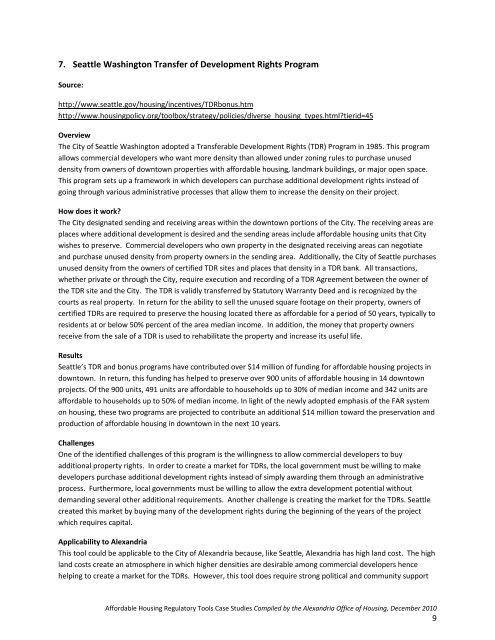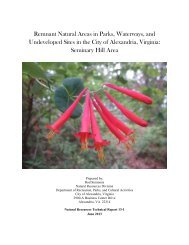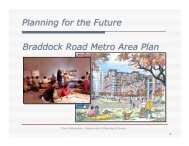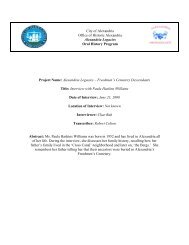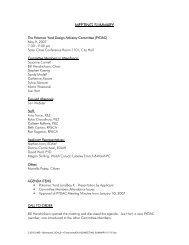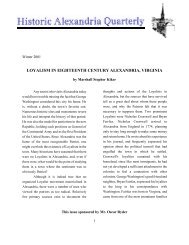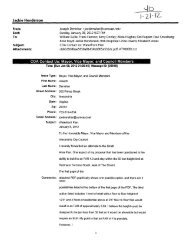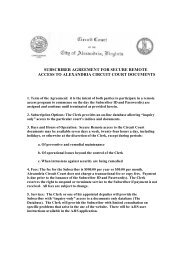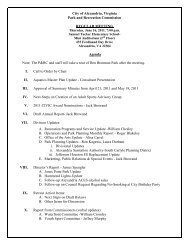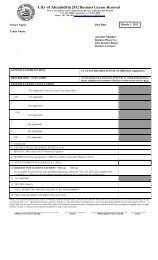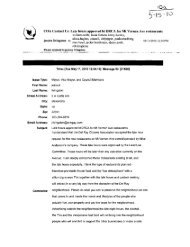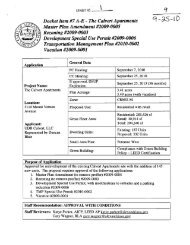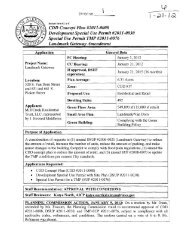Case Studies - Affordable Housing Regulatory ... - City of Alexandria
Case Studies - Affordable Housing Regulatory ... - City of Alexandria
Case Studies - Affordable Housing Regulatory ... - City of Alexandria
You also want an ePaper? Increase the reach of your titles
YUMPU automatically turns print PDFs into web optimized ePapers that Google loves.
7. Seattle Washington Transfer <strong>of</strong> Development Rights Program<br />
Source:<br />
http://www.seattle.gov/housing/incentives/TDRbonus.htm<br />
http://www.housingpolicy.org/toolbox/strategy/policies/diverse_housing_types.html?tierid=45<br />
Overview<br />
The <strong>City</strong> <strong>of</strong> Seattle Washington adopted a Transferable Development Rights (TDR) Program in 1985. This program<br />
allows commercial developers who want more density than allowed under zoning rules to purchase unused<br />
density from owners <strong>of</strong> downtown properties with affordable housing, landmark buildings, or major open space.<br />
This program sets up a framework in which developers can purchase additional development rights instead <strong>of</strong><br />
going through various administrative processes that allow them to increase the density on their project.<br />
How does it work?<br />
The <strong>City</strong> designated sending and receiving areas within the downtown portions <strong>of</strong> the <strong>City</strong>. The receiving areas are<br />
places where additional development is desired and the sending areas include affordable housing units that <strong>City</strong><br />
wishes to preserve. Commercial developers who own property in the designated receiving areas can negotiate<br />
and purchase unused density from property owners in the sending area. Additionally, the <strong>City</strong> <strong>of</strong> Seattle purchases<br />
unused density from the owners <strong>of</strong> certified TDR sites and places that density in a TDR bank. All transactions,<br />
whether private or through the <strong>City</strong>, require execution and recording <strong>of</strong> a TDR Agreement between the owner <strong>of</strong><br />
the TDR site and the <strong>City</strong>. The TDR is validly transferred by Statutory Warranty Deed and is recognized by the<br />
courts as real property. In return for the ability to sell the unused square footage on their property, owners <strong>of</strong><br />
certified TDRs are required to preserve the housing located there as affordable for a period <strong>of</strong> 50 years, typically to<br />
residents at or below 50% percent <strong>of</strong> the area median income. In addition, the money that property owners<br />
receive from the sale <strong>of</strong> a TDR is used to rehabilitate the property and increase its useful life.<br />
Results<br />
Seattle’s TDR and bonus programs have contributed over $14 million <strong>of</strong> funding for affordable housing projects in<br />
downtown. In return, this funding has helped to preserve over 900 units <strong>of</strong> affordable housing in 14 downtown<br />
projects. Of the 900 units, 491 units are affordable to households up to 30% <strong>of</strong> median income and 342 units are<br />
affordable to households up to 50% <strong>of</strong> median income. In light <strong>of</strong> the newly adopted emphasis <strong>of</strong> the FAR system<br />
on housing, these two programs are projected to contribute an additional $14 million toward the preservation and<br />
production <strong>of</strong> affordable housing in downtown in the next 10 years.<br />
Challenges<br />
One <strong>of</strong> the identified challenges <strong>of</strong> this program is the willingness to allow commercial developers to buy<br />
additional property rights. In order to create a market for TDRs, the local government must be willing to make<br />
developers purchase additional development rights instead <strong>of</strong> simply awarding them through an administrative<br />
process. Furthermore, local governments must be willing to allow the extra development potential without<br />
demanding several other additional requirements. Another challenge is creating the market for the TDRs. Seattle<br />
created this market by buying many <strong>of</strong> the development rights during the beginning <strong>of</strong> the years <strong>of</strong> the project<br />
which requires capital.<br />
Applicability to <strong>Alexandria</strong><br />
This tool could be applicable to the <strong>City</strong> <strong>of</strong> <strong>Alexandria</strong> because, like Seattle, <strong>Alexandria</strong> has high land cost. The high<br />
land costs create an atmosphere in which higher densities are desirable among commercial developers hence<br />
helping to create a market for the TDRs. However, this tool does require strong political and community support<br />
<strong>Affordable</strong> <strong>Housing</strong> <strong>Regulatory</strong> Tools <strong>Case</strong> <strong>Studies</strong> Compiled by the <strong>Alexandria</strong> Office <strong>of</strong> <strong>Housing</strong>, December 2010<br />
9


